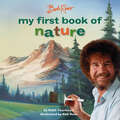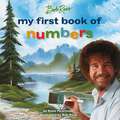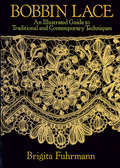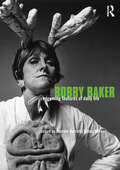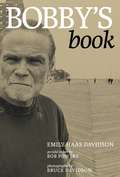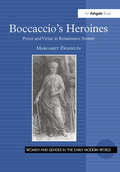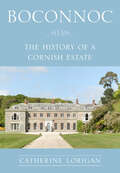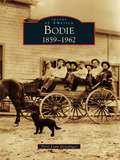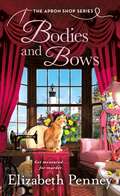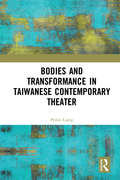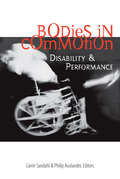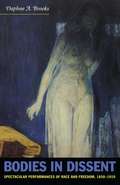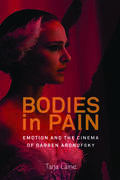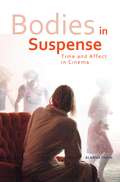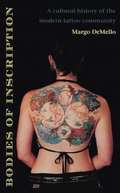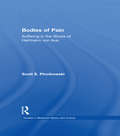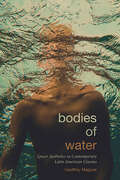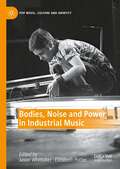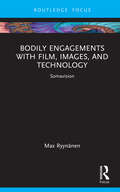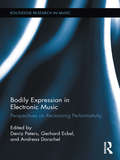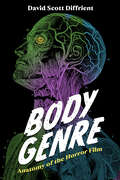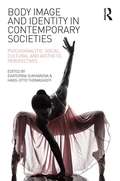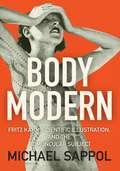- Table View
- List View
Bob Ross: My First Book of Colors
by Robb PearlmanA titanium snowcapped mountain. A happy little tree made with Van Dyke Brown and Dark Sienna. A majestic, vibrant phthalo blue sky. Bob Ross: My First Book of Colors is an early concept board book featuring various Bob Ross paintings and some of Bob's little quips about each of the thirteen colors he used on his palette in front of TV audiences. Full of real paintings from the iconic artist, this is sure to be a hit for any Bob Ross fan.Colors include: Alizarin Crimson Bright Red Cadmium Yellow Hue Dark Sienna Indian Yellow Midnight Black Phthalo Blue Prussian Blue Sap Green Titanium White Van Dyke Brown Yellow Ochre
Bob Ross: My First Book of Nature (My First Bob Ross Books)
by Robb PearlmanThe second official board book featuring Bob Ross's stunning, iconic paintings with a special nod to the natural world.Happy little clouds. Tall, snow-capped mountains. River rocks. The beauty of nature is everywhere. Bob Ross: My First Book of Nature is an early concept board book featuring various Bob Ross paintings and some of Bob's little quips about all of the beautiful sights seen in nature and that he painted in front of TV audiences. Full of real paintings from the iconic artist, this follow up to Bob Ross: My First Book of Colors is sure to be a hit for any Bob Ross fan.
Bob Ross: My First Book of Numbers (My First Bob Ross Books)
by Robb PearlmanToddlers will learn their numbers and basic counting skills with Bob Ross and his 13 paints in this early concept board book. Count your way to thirteen in this serene and peaceful early concept board book in the Bob Ross My First Book series, which includes Bob Ross: My First Book of Colors and Bob Ross: My First Book of Nature! Count one bright moon, two friends, three (then four) trees, five rocks, and more with iconic painter Bob Ross as he quips and reminds you to take things slowly. Illustrated using real paintings created by Bob Ross, this is a perfect board book for fans young and old alike! Copyright © 2023 by Bob Ross Inc. ®Bob Ross name and images are registered trademarks of Bob Ross Inc. © Bob Ross Inc. Used with Permission. All rights reserved.
Bobbin Lace: An Illustrated Guide to Traditional and Contemporary Techniques
by Brigita FuhrmannAfter over a century of relative obscurity, lacemaking is enjoying a revival as more and more needlecraft artists are intrigued by its creative possibilities. Dating from the 15th century, bobbin lace is prized everywhere for its intricacy, delicacy, and decorative richness -- and couldn't be easier to do!In this modern, step-by-step approach to the craft, noted lacemaker Brigita Fuhrmann shows you how to create every kind of bobbin lace -- from the simplest stitch to the most challenging pattern. In addition, she traces the history of bobbin lacemaking in Western and Eastern Europe (including Russia) and relates these two distinct types to contemporary trends.For all its intricate, elegant appearance, bobbin lace is based on only two different movements of bobbins -- the cross and the twist. Essentially, it is the technique of winding threads on bobbins around pins attached to a firm pillow. The pins hold the lace in place while you cross and twist the bobbins over each other in varying sequences to form a wide range of stitches. The richness of the lace depends on how you combine the stitches into a pattern.Ms. Fuhrmann provides expert advice on the tools you'll need -- pillows, bobbins, pins, and thread -- and easy-to-follow instructions for a variety of exquisite stitches. Clear, accurate diagrams accompany stitch directions, beginning with the braid and Brussels ground and ending with the maiden's net and spiders. Learn how to make stunning straight lace and tape lace; construct fans, corners, edgings; draft patterns; finish your creations, and care for your lace.Needleworkers at all levels of expertise will welcome this comprehensive volume. Experienced hands will discover endless challenges and inspiration here; beginners will find this an excellent introduction to the beauty and elegance of a time-honored art form.
Bobby Baker: Redeeming Features of Daily Life
by Michèle Barrett Bobby BakerBobby Baker is one of most widely acclaimed and popular performance artists working today. Over the course of a thirty-five-year career she has toured the globe with her wildly stimulating explorations of 'Daily Life' and has been extensively written about and studied. This fully-illustrated book brings together for the first time an account of Baker's career as an artist – from her first sculptures at Central St Martins in the early 1970s to her most recent work, 'How to Live' and 'Diary Drawings' – with critical commentary by reviewers and academic practitioners. It includes: Bobby Baker's own 'Chronicle' of her work as artist and performer illuminating critical writing about Baker's shows transcripts of Baker's performances and other original materials reproduced here for the first time significant new essays by Michele Barrett and Griselda Pollock a new interview with Bobby Baker by Adrian Heathfield. Under the guiding editorial hand of distinguished cultural theorist Michèle Barrett, this volume is an essential text for students interested in performance, gender, and visual culture, and a hugely absorbing and accessible account of Baker's work.
Bobby's Book
by Bob Powers Emily Davidson Bruce DavidsonIn 1998, at the very moment that a publisher had approached Bruce Davidson about a book of his 1959 Brooklyn Gang photographs, former gang leader Bobby Powers unexpectedly telephoned the Davidsons. Over the next decade, Emily Davidson maintained an ongoing conversation with Powers in order to bring to light his struggle to overcome his drug-ridden and violent past and to inspire others with his example. Through the words and reflections of the former drug addict and petty criminal, this book relates the long, agonizing journey from youthful urban violence and despair to the life of a committed and generous professional. Beginning in a working-class Brooklyn neighborhood in the mid 1950s where alcohol abuse and poverty were rampant, Bobby Powers went from being an illiterate gang leader and notorious drug dealer to a destroyed individual who had lost everything, including family members, close friends, and himself, all presented in his own words and in grim detail in this book. At a critical turning point in his life, recognizing the threat of his behaviors to survival, he entered detox and embarked on the arduous path to recovery and self-understanding. This process involved not only acknowledging and coming to terms with the injuries he had inflicted on his children and others, but also asking for their forgiveness. Having achieved a new way of life as a responsible and caring adult, Bobby Powers is today, at 69, a nationally respected drug addiction counselor who has aided a wide spectrum of people, including former gang members. His story represents a brutal and inspiring lesson in human frailty, degradation, and transformation.
Boccaccio's Heroines: Power and Virtue in Renaissance Society (Women and Gender in the Early Modern World)
by Margaret FranklinIn contrast to earlier scholars who have seen Boccaccio's Famous Women as incoherent and fractured, Franklin argues that the text offers a remarkably consistent, coherent and comprehensible treatise concerning the appropriate functioning of women in society. In this cross disciplinary study of a seminal work of literature and its broader cultural impact on Renaissance society, Franklin shows that, through both literature and the visual arts, Famous Women was used to promote social ideologies in both Renaissance Tuscany and the dynastic courts of northern Italy. Speaking equally to scholars in medieval and early modern literature, history, and art history, Franklin brings needed clarification to the text by demonstrating that the moral criteria Boccaccio used to judge the lives of legendary women - heroines and miscreants alike - were employed consistently to tackle the challenge that politically powerful women represented for the prevailing social order. Further, the author brings to light the significant influence of Boccaccio's text on the representation of classical heroines in Renaissance art. By examining several paintings created in the republics and principalities of Renaissance Italy, Franklin demonstrates that Famous Women was employed as a conceptual guide by patrons and artists to draw the teeth from the challenge of unconventionally powerful women by co-opting their stories into the service of contemporary Italian standards and mores.
Boconnoc: The History of a Cornish Estate
by Catherine LoriganThe story of the estate at Boconnoc, situated near Lostwithiel in south-east Cornwall, is an extraordinary one. As this history demonstrates, members of the Cornish families who have owned the estate over many centuries have played important roles within the immediate locality and in national events. Catherine Lorigan explores their eventful lives – or in many cases deaths: dragged over a cliff by greyhounds, slain in battle, executed for treason or killed in duels. She traces how the medieval fortified tower house evolved into a Georgian mansion, discusses how the grounds and gardens have been transformed, and examines the relationship of the estate with the agricultural and industrial landscape in which it is set. Still family owned and run, Boconnoc retains the qualities that give it its magical and timeless ambience, while simultaneously, it has become a dynamic and successful business for the twenty-first century.
Bodie: 1859-1962
by Terri Lynn GeissingerNestled amongst the sage-covered, windswept hills of California's Eastern Sierra is the site of one of the most notorious mining towns of the Old West. In 1859, gold was discovered in the treeless hills northeast of Mono Lake. By 1879, Bodie was a metropolis of nearly 10,000 souls and was briefly the third-largest city in California. Excitement was short-lived, however, and word soon spread that the mines had reached peak production. An exodus began, but contrary to popular belief, Bodie was never totally abandoned. People continued living in this curious and beautiful place throughout the 1950s, and in 1962, the California State Parks system purchased the town site. Now stabilized against the elements, Bodie is today known as the largest unrestored ghost town in the West.
Bodies and Bows: The Apron Shop Series (Apron Shop Series #3)
by Elizabeth PenneyBodies & Bows is the third in the charming cozy Iris Buckley mystery series set in an apron shop in Maine—Elizabeth Penney will have you on pins and needles…Iris Buckley is hoping for a bit of rest and relaxation now that the summertime rush is winding down in Blueberry Cove, Maine. Her apron shop Ruffles & Bows has been a huge success, her friendships are stronger than ever, and now she’s ready for all of the end of summer cookouts on the beach that she can handle.But before Iris can even turn on the grill, Bella’s latest fling, former Olympian sailor and gorgeous bad boy Lance Pederson is killed in a hit and run while jogging at dawn—and all the evidence points to Bella herself.Suddenly the month of August isn’t looking so restful, since now Iris has been roped into the Lighthouse Rehabilitation Committee, helping her friend Sophie plan a wedding, and—most importantly of all—tracking down a killer and clearing Bella’s good name before everything unravels.
Bodies and Transformance in Taiwanese Contemporary Theater
by Peilin LiangIn Bodies and Transformance in Taiwanese Contemporary Theater, Peilin Liang develops a theory of bodily transformation. Proposing the concept of transformance, a conscious and rigorous process of self-cultivation toward a reconceptualized body, Liang shows how theater practitioners of minoritized cultures adopt transformance as a strategy to counteract the embodied practices of ideological and economic hegemony. This book observes key Taiwanese contemporary theater practitioners at work in forging five reconceptualized bodies: the energized, the rhythmic, the ritualized, the joyous, and the (re)productive. By focusing on the development of transformance between the years of 2000–2008, a tumultuous political watershed in Taiwan’s history, the author succeeds in bridging postcolonialism and interculturalism in her conceptual framework. Ideal for scholars of Asian and postcolonial theater, Bodies and Transformance in Taiwanese Contemporary Theater shows how transformance, rather than performance, calibrates with far greater precision and acuity the state of the body and the culture that it seeks to create.
Bodies in Commotion: Disability and Performance
by Carrie Sandahl Philip Auslander"A testament to the synergy of two evolving fields. From the study of staged performances to examinations of the performing body in everyday life, this book demonstrates the enormous profitability of moving beyond disability as metaphor. . . . It's a lesson that many of our cultural institutions desperately need to learn. " -Martin F. Norden, University of Massachusetts-Amherst This groundbreaking collection imagines disabled bodies as "bodies in commotion"-bodies that dance across artistic and discursive boundaries, challenging our understanding of both disability and performance. In the book's essays, leading critics and artists explore topics that range from theater and dance to multi-media performance art, agit-prop, American Sign Language theater, and wheelchair sports. Bodies in Commotionis the first collection to consider the mutually interpretive qualities of these two emerging fields, producing a dynamic new resource for artists, activists, and scholars.
Bodies in Dissent: Spectacular Performances of Race and Freedom, 1850–1910
by Daphne A. BrooksIn Bodies in Dissent Daphne A. Brooks argues that from the mid-nineteenth century to the early twentieth, black transatlantic activists, actors, singers, and other entertainers frequently transformed the alienating conditions of social and political marginalization into modes of self-actualization through performance. Brooks considers the work of African American, Anglo, and racially ambiguous performers in a range of popular entertainment, including racial melodrama, spectacular theatre, moving panorama exhibitions, Pan-Africanist musicals, Victorian magic shows, religious and secular song, spiritualism, and dance. She describes how these entertainers experimented with different ways of presenting their bodies in public--through dress, movement, and theatrical technologies--to defamiliarize the spectacle of "blackness" in the transatlantic imaginary.Brooks pieces together reviews, letters, playbills, fiction, and biography in order to reconstruct not only the contexts of African American performance but also the reception of the stagings of "bodily insurgency" which she examines. Throughout the book, she juxtaposes unlikely texts and entertainers in order to illuminate the complicated transatlantic cultural landscape in which black performers intervened. She places Adah Isaacs Menken, a star of spectacular theatre, next to Sojourner Truth, showing how both used similar strategies of physical gesture to complicate one-dimensional notions of race and gender. She also considers Henry Box Brown's public re-enactments of his escape from slavery, the Pan-Africanist discourse of Bert Williams's and George Walker's musical In Dahomey (1902-04), and the relationship between gender politics, performance, and New Negro activism in the fiction of the novelist and playwright Pauline Hopkins and the postbellum stage work of the cakewalk dancer and choreographer Aida Overton Walker. Highlighting the integral connections between performance and the construction of racial identities, Brooks provides a nuanced understanding of the vitality, complexity, and influence of black performance in the United States and throughout the black Atlantic.
Bodies in Pain: Emotion and the Cinema of Darren Aronofsky
by Tarja LaineThe films of Darren Aronofsky invite emotional engagement by means of affective resonance between the film and the spectator’s lived body. Aronofsky’s films, which include a rich range of production from Requiem for a Dream to Black Swan, are often considered “cerebral” because they explore topics like mathematics, madness, hallucinations, obsessions, social anxiety, addiction, psychosis, schizophrenia, and neuroscience. Yet this interest in intelligence and mental processes is deeply embedded in the operations of the body, shared with the spectator by means of a distinctively corporeal audiovisual style. Bodies in Pain looks at how Aronofsky’s films engage the spectator in an affective form of viewing that involves all the senses, ultimately engendering a process of (self) reflection through their emotional dynamics.
Bodies in Suspense: Time and Affect in Cinema
by Alanna ThainBodies in Suspense presents a powerful new way to think through postdigital cinema and the affective turn in critical theory. According to Alanna Thain, suspense films allow us to experience the relation between two bodies: that of the film and that of the viewer. Through the &“time machine&” of suspense, film form, gender, genre, and spectatorship are revealed in innovative and different ways. These films not only engage us directly in ethical concerns, but also provide a key for understanding corporeal power in the digital era. Offering a new framework for understanding cinematic suspense, Bodies in Suspense argues that the &“body in time&” enables us to experience the temporal dimension of the body directly. This is the first book to link two contemporary frames of analysis: questions of cinematic temporality and contemporary affect theory. Thain conducts close readings of influential suspense films by Alfred Hitchcock, David Lynch, Christian Marclay, Rian Johnson, and Lou Ye, and sets forth a compelling new theory of cinema, reading for the productivity of the &“crime of time&” that stages the duplicity of cinematic bodies. Through these films that foreground doubled characters and looping, Thain explores Gilles Deleuze&’s claim that &“the direct time-image is the phantom which has always haunted cinema.&”A vital new addition to film theory, corporeality and affect theory, feminist theory, and the philosophy of time—and one of the first books to explore David Lynch&’s Hollywood trilogy—Bodies in Suspense asks us to pay attention, above all, to the ways in which the condition of spectatorship creates a doubling sensation with important philosophical repercussions.
Bodies of Inscription: A Cultural History of the Modern Tattoo Community
by Margo Demello Gayle S. RubinSince the 1980s, tattooing has emerged anew in the United States as a widely appealing cultural, artistic, and social form. In Bodies of Inscription Margo DeMello explains how elite tattooists, magazine editors, and leaders of tattoo organizations have downplayed the working-class roots of tattooing in order to make it more palatable for middle-class consumption. She shows how a completely new set of meanings derived primarily from non-Western cultures has been created to give tattoos an exotic, primitive flavor. Community publications, tattoo conventions, articles in popular magazines, and DeMello's numerous interviews illustrate the interplay between class, culture, and history that orchestrated a shift from traditional Americana and biker tattoos to new forms using Celtic, tribal, and Japanese images. DeMello's extensive interviews reveal the divergent yet overlapping communities formed by this class-based, American-style repackaging of the tattoo. After describing how the tattoo has moved from a mark of patriotism or rebellion to a symbol of exploration and status, the author returns to the predominantly middle-class movement that celebrates its skin art as spiritual, poetic, and self-empowering. Recognizing that the term "community" cannot capture the variations and class conflict that continue to thrive within the larger tattoo culture, DeMello finds in the discourse of tattooed people and their artists a new and particular sense of community and explores the unexpected relationship between this discourse and that of other social movements. This ethnography of tattooing in America makes a substantive contribution to the history of tattooing in addition to relating how communities form around particular traditions and how the traditions themselves change with the introduction of new participants. Bodies of Inscription will have broad appeal and will be enjoyed by readers interested in cultural studies, American studies, sociology, popular culture, and body art.
Bodies of Pain: Suffering in the Works of Hartmann von Aue (Studies in Medieval History and Culture #11)
by Scott E. PincikowskiFirst Published in 2002. Routledge is an imprint of Taylor & Francis, an informa company.
Bodies of Water: Queer Aesthetics in Contemporary Latin American Cinema (SUNY series in Latin American Cinema)
by Geoffrey MaguireRivers, swimming pools, lakes, and oceans: these watery spaces recur with remarkable frequency in recent queer Latin American cinema, urging us to question the intimacies between queerness and the aquatic. Unpredictable and uncontrollable, water reflects a natural fluidity in our sexual desires and orientations; it is both a space and a substance, one in which bodies surrender themselves to the natural forces of currents and flows. As the first book to investigate water's queer cinematic potential, Bodies of Water proposes that we think not only about water but also through it, illuminating new directions for the study of queer world cinema and its evolving aesthetic strategies. Bodies of Water engages critically with theories of cinematic embodiment and recent work in queer theory and the environmental humanities, foregrounding a region of the world historically overlooked in global discussions of queerness. By examining the radical queer epistemologies that emerge at the convergence of body, camera, and water, Bodies of Water ultimately poses a question of both critical and sociopolitical concern: what's so queer about cinematic waters?
Bodies, Noise and Power in Industrial Music (Pop Music, Culture and Identity)
by Jason Whittaker Elizabeth PotterThis edited collection delves into the industrial music genre, exploring the importance of music in (sub)cultural identity formation, and the impact of technology on the production of music. With its roots as early as the 1970s, industrial music emerged as a harsh, transgressive, and radically charged genre. The soundscape of the industrial is intense and powerful, adorned with taboo images, and thematically concerned with authority and control. Elemental to the genre is critical engagement with configurations of the body and related power. Adopting an interdisciplinary approach, this collection analyses the treatment of subjects like the Body (animal, human, machine), Noise (rhythmic, harsh) and Power (authority, institutions, law) in a variety of industrial music’s elements. Throughout the collection, these three subjects are interrogated by examining lyrics, aesthetics, music videos, song writing, performance and audience reception. The chapters have been carefully selected to produce a diverse and intersectional perspective, including work on Black industrial musicians and Arabic and North African women’s collaborations. Rather than providing historical context, the contributors interpret the finer elements of the aesthetics and discourses around physical bodies and power as expressed in the genre, expanding the ‘industrial’ boundary and broadening the focus beyond white European industrial music.
Bodily Engagements with Film, Images, and Technology: Somavision (Routledge Focus on Art History and Visual Studies)
by Max RyynänenThis book builds a new understanding of the body and its relationship to images and technology, using a framework where novel writings of pragmatist somaesthetics and phenomenology meet new research on bodily reactions. Max Ryynänen gives an overview of the topic by collecting the existing information of our bodies gazing at visual culture and the philosophies supporting these phenomena, and examines the way the gaze and the body come together in our relationship to culture. Themes covered include somatic film; the body in artistic documentation of activist art; body parts (and their mutilation or surgeries) in contemporary art and film; robot cars and our visual relationship to them; the usefulness of Indian rass philosophy in explaining digital culture; and an examination of Mario Perniola’s work about the idea that we, human beings, are increasingly experiencing ourselves to be simply "things." The book will be of interest to scholars working in art history, aesthetics, cultural philosophy, film studies, technology studies, media studies, cultural studies, and visual studies.
Bodily Expression in Electronic Music: Perspectives on Reclaiming Performativity (Routledge Research in Music)
by Deniz Peters Gerhard Eckel Andreas DorschelIn this book, scholars and artists explore the relation between electronic music and bodily expression from perspectives including aesthetics, philosophy of mind, phenomenology, dance and interactive performance arts, sociology, computer music and sonic arts, and music theory, transgressing disciplinary boundaries and established beliefs. The historic decoupling of action and sound generation might be seen to have distorted or even effaced the expressive body, with the retention of performance qualities via recoupling not equally retaining bodily expressivity. When, where, and what is the body expressed in electronic music then? The authors of this book reveal composers’, performers’, improvisers’ and listeners’ bodies, as well as the works’ and technologies’ figurative bodies as a rich source of expressive articulation. Bringing together humanities’ scholarship and musical arts contingent upon new media, the contributors offer inspiring thought and critical reflection for all those seriously engaged with the aesthetics of electronic music, interactive performance, and the body’s role in aesthetic experience and expression. Performativity is not only seen as being reclaimed in live electronic music, interactive arts, and installations; it is also exposed as embodied in the music and the listeners themselves.
Body Genre: Anatomy of the Horror Film (Horror and Monstrosity Studies Series)
by David Scott DiffrientIn this groundbreaking work, author David Scott Diffrient explores largely understudied facets of cinematic horror, from the various odors permeating classic and contemporary films to the wetness, sliminess, and stickiness of these productions, which, he argues, practically scream out for a tactile mode of textural analysis as much as they call for more traditional forms of textual analysis. Dating back to Carol Clover’s and Linda Williams’s pioneering work on horror cinema, film scholars have long conceptualized this once-disreputable category of cultural production as a “body genre.” However, despite the growing recognition that horror serves important biological and social functions in our lives, scholars have only scratched the surface of this genre with regard to its affective, corporeal, and sensorial appeals.Diffrient anatomizes horror films in much the same way that a mad scientist might handle the body, separating and recombining constitutive parts into a new analytical whole. Further, he challenges the tendency of scholars to privilege human over nonhuman beings and calls into question ableist assumptions about the centrality to horror films of sight and sound to the near exclusion of other forms of sense experience. In addition to examining the role that animals—living or dead, real or fake—play in human-centered fictions, this volume asks what it means for audiences to consume motion pictures in which actors, stunt performers, and other creative personnel have put their own bodies and lives at risk for our amusement. Historically grounded and theoretically expansive, Body Genre: Anatomy of the Horror Film moves the study of cinematic horror into previously unchartered waters and breathes life into a subject that, not coincidentally, is intimately connected to breathing as our most cherished dividing line between life and death.
Body Image and Identity in Contemporary Societies: Psychoanalytic, social, cultural and aesthetic perspectives
by Ekaterina Sukhanova Hans-Otto ThomashoffPopular interest in body image issues has grown dramatically in recent years, due to an emphasis on individual responsibility and self-determination in contemporary society as well as the seemingly limitless capacities of modern medicine; however body image as a separate field of academic inquiry is still relatively young. The contributors of Body Image and Identity in Contemporary Societies explore the complex social, political and aesthetic interconnections between body image and identity. It is an in-depth study that allows for new perspectives in the analysis of contemporary visual art and literature but also reflects on how these social constructs inform clinical treatment. Sukhanova and Thomashoff bring together contributions from psychoanalysts, psychotherapists, psychiatrists and scholars in the fields of the social sciences and the humanities to explore representations of the body in literature and the arts across different times and cultures. The chapters analyse the social construction of the 'ideal' body in terms of beauty, gender, sexuality, race, ethnicity, class and disability, from a broadly psychoanalytic perspective, and traces the mechanisms which define the role of the physical appearance in the formation of identity and the assumption of social roles. Body Image and Identity in Contemporary Societies' unique interdisciplinary outlook aims to bridge the current gap between clinical observations and research in semiotic theory. It will be of interest to psychoanalysts, psychotherapists, art therapists, art theorists, academics in the humanities and social sciences, and those interested in an interdisciplinary approach to the issues of body image and identity. Ekaterina Sukhanova is University Director of Academic Program Review at the City University of New York USA. She serves as Scientific Secretary of the Section for Art and Psychiatry and the Section of Art and Psychiatry of the World Psychiatric Association. She is also engaged in interdisciplinary research on cultural constructs of mental health and illness and curates exhibits of art brut as a vehicle for fighting stigma. Hans-Otto Thomashoff was born in Germany and lives in Vienna. He is a psychiatrist, psychoanalyst, art historian and author of fiction and non-fiction books. He has been curator of several art exhibitions highlighting the connection between the psyche and art as well as president of the section of Art and Psychiatry of the World Psychiatric Association and advisory committee member of the Sigmund Freud Foundation, Vienna.
Body Language: The Queer Staged Photographs of George Platt Lynes and PaJaMa (Defining Moments in Photography #7)
by Dr. Angela MillerExamines early practices of staged photography in visualizing queer forms of relation. Body Language is the first in-depth study of the extraordinary interplay between George Platt Lynes and PaJaMa (Paul Cadmus, Jared French, and Margaret Hoening French). Nick Mauss and Angela Miller offer timely readings of how their practices of staging, collaboration, and psychological enactment through the body arced across the boundaries of art and life, private and public worlds, anticipating contemporary social media. Using the camera not to capture, but to actively perform, they renounced photography’s conventional role as mirror of the real, energizing forms of world-making via a new social framing of the self.
Body Modern: Fritz Kahn, Scientific Illustration, and the Homuncular Subject
by Michael SappolA poster first printed in Germany in 1926 depicts the human body as a factory populated by tiny workers doing industrial tasks. Devised by Fritz Kahn (1888–1968), a German-Jewish physician and popular science writer, &“Der Mensch als Industriepalast&” (or &“Man as Industrial Palace&”) achieved international fame and was reprinted, in various languages and versions, all over the world. It was a new kind of image—an illustration that was conceptual and scientific, a visual explanation of how things work—and Kahn built a career of this new genre. In collaboration with a stable of artists (only some of whom were credited), Kahn created thousands of images that were metaphorical, allusive, and self-consciously modern, using an eclectic grab-bag of schools and styles: Dada, Art Deco, photomontage, Art Nouveau, Bauhaus functionalism, and commercial illustration. In Body Modern, Michael Sappol offers the first in-depth critical study of Fritz Kahn and his visual rhetoric. Kahn was an impresario of the modern who catered to readers who were hungry for products and concepts that could help them acquire and perform an overdetermined &“modern&” identity. He and his artists created playful new visual tropes and genres that used striking metaphors to scientifically explain the &“life of Man.&” This rich and largely obscure corpus of images was a technology of the self that naturalized the modern and its technologies by situating them inside the human body.The scope of Kahn&’s project was vast—entirely new kinds of visual explanation—and so was his influence. Today, his legacy can be seen in textbooks, magazines, posters, public health pamphlets, educational websites, and Hollywood movies. But, Sappol concludes, Kahn&’s illustrations also pose profound and unsettling epistemological questions about the construction and performance of the self. Lavishly illustrated with more than 100 images, Body Modern imaginatively explores the relationship between conceptual image, image production, and embodied experience.

